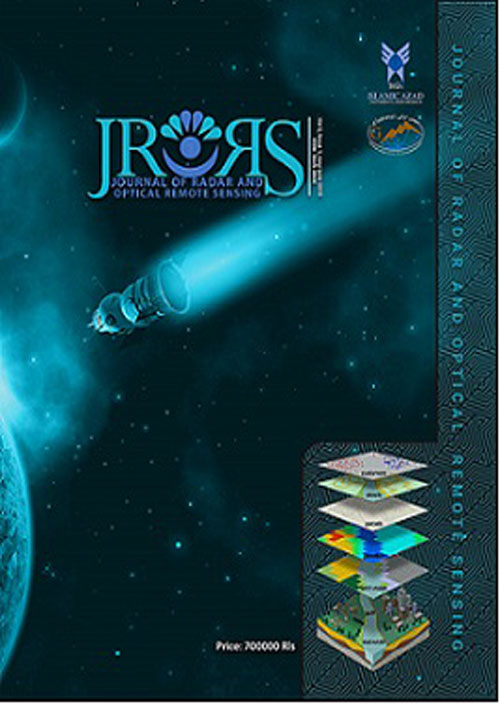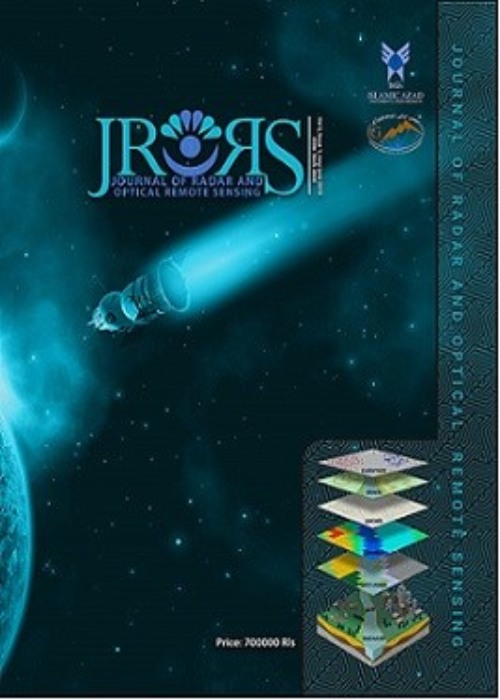فهرست مطالب

Journal of Radar and Optical Remote Sensing
Volume:3 Issue: 1, Winter 2020
- تاریخ انتشار: 1400/03/25
- تعداد عناوین: 6
-
Pages 7-20Identifying suitable and optimal areas for camouflage of arsenals is very important. The purpose of this study is to investigate and select the optimal and suitable places for camouflage of arsenals in the country using AHP model and mathematical analysis in ARC GIS environment. Locating is a process through which the best place for an activity can be determined based on the conditions and according to the available resources and facilities. Accordingly, in this study, first the effective factors in locating the ammunition slot are examined and the map of each of the effective factors in locating the arsenal such as slope map, slope direction map, Altitude map, Access road map, Distance from big cities map, Distance from medium cities map, Distance from small towns Map, Distance from villages map, Distance from faults map and distance from water level map were prepared in ARC GIS environment and the importance coefficients of criteria and sub-criteria were obtained using Analytic Hierarchy Process (AHP) and Expert Choice software. Then, these coefficients were applied in the layers related to each parameter through a linear weight combination and suitable places for selecting the arsenal were identified with a range of values.Keywords: Arsenal, Positioning System, Analytical Hierarchy Process (AHP), Geographic Information System (GIS), Iran
-
Pages 21-34
The aim of this research is to evaluate the rain erosion index in Iran by using the rainfall records from 150 stations over the period of 25-year (2010-1986), using geo-statistical methods. To calculate the rainfall erodibility, factor, and using Fournier index equation, the R factors for all stations were received. The rainfall erosivity factor map was depicted to show the spatial correlation between rainfall erosivity statistics, depicting of variogram become used that the linear to sill variogram with the value of 0.80 confirmed the quality correlation the various facts and was used for the interpolation. Also, to evaluate the amount of rainfall erosivity indexes four extraordinary interpolation methods (IDW) had been used: (GPI), (RBF) local, (LPI), and kriging. Moreover, to choose the satisfactory approach of interpolation, correlation of Geo-statistical techniques with the observational data has been estimated. Kriging simple method with R2 = 0.74 has been chosen as the satisfactory technique. Based on the result of kriging simple and DEM maps of Iran, the area of 8.98-27.19 has the best stage (22.5) and is as much as to 4777 m. The lowest level is allocated to regain 2.12.49, which covers approximately 4.2% of the entire area of Iran. The evaluation confirms the immoderate indices of erosivity for the northern strip and the west provinces of country due to the heavy monthly rainfall.
Keywords: GIS, interpolation, Kriging, R factor, Variogram -
Pages 35-45
One of the most important developmental procedures for the implementation of oil and gas transmission projects is through pipelines. Route selection is a crucial step in the planning of transmission lines. In this regard, to choose applicable and optimal route is likely to be complicated. Many factors need to be taken into consideration hence this is a very important stage in the transmission lines project. Using remote sensing (RS) and geographic information systems (GIS), new valves for routing will be unlocked and the costs of inaccuracies and inappropriate plans will be significantly reduced. The first modeling stage for planning and routing is defining the factors that determine the route of transmission of oil pipelines. There are diverse effective factors in determining the route to the transmission pipeline projects. Also, the proportion of the impact of each of these factors must be identified. The weight of the factors, is determined by various methods. These factors include roads, rivers, landslides, faults, gradients of land, soil science, land use, geology, recreational areas and protected areas. Finally, the cost of transfer plan for each pixel is designed using the multi-criteria decision making model and the AHP method in the GIS environment. Using this map, a cumulative cost map for the origin and destination is designed.
Keywords: Remote Sensing RS, GIS Geographic Information System, Routing Transmission Lines -
Pages 46-54
Today, due to the access importance to precise, comprehensive and daily spatial information of the various phenomena and the change over time in terms of location and nature. In order to monitor their behavior and the possibility of planning and deciding in different cases, it have been attempting to improve the imaging performance with increasing spatial accuracy, radiometric spectra of the sensors. But each improvement stage requires time and cost, and taking into account different periods and sometimes long periods of imaging of a point on Ground level (low time resolution), which is due to smaller FOV (increased spatial accuracy). However, daily monitoring of many features is not possible, especially those that are smaller than the sensor's pixel size. Therefore, it is necessary to use, methods for features extraction from low resolution images, in which the feature dimensions and the spatial resolution of sensor is of fundamental situation. In this research, attempt has been made to investigate the possibility of various possible modes, including the location of the barge in the image, the images taken in different bands of emission, radiance, reflection, the presence of two features side by side, the effect of flame on adjacent feature, the study of noisy bands, the presence or absence of flame, non-solid features such as platforms and solid features, such as barge, on different days of the year.
Keywords: detection, MODIS, Reflectance bands, Subpixel -
Pages 55-66Groundwater resources are considered as the main and most important sources of drinking water,agriculture and industry. It is necessary to study the quality change and decline in the balance ofthese resources as a result of improper drawing, inappropriate temporal and spatial distribution ofwater resources in Iran and low irrigation efficiency in agriculture, has made water the mostlimiting factor of production in agriculture. In the present study, the fields under cultivation withvarious crops were studied in terms of the effect of cultivating different plants on groundwaterresources in the lands of Moghan Agriculture, Industry and Animal Husbandry Company atdifferent time period according to the type of crop cultivated. For this purpose, spatial andtemporal modeling of the change process was carried out. The results showed that due tosuccessive cultivation and the use of crops that need a lot of water for cultivation, water in two wells in the region has become saline and the water level has decreased.Keywords: Groundwater, Moghan Plain, Modeling, agriculture
-
Pages 67-76Nowadays, various systems and, tools have been used to study the components of the atmosphere. In atmospheric correction of satellite images, it is necessary to identify and use the specifications of the atmosphere during satellite crossing. For this purpose, in this research, designed and constructed an optimal sun-photometer system to determine the local atmospheric parameter. LabVIEW environment has been used to record Aerosol Optical Depth (AOD) data and guide motors in two axes for accurate sun tracking. In this research, by calculating the aerosols optical depth and studying its behavior on different days, two CCD (Charge-Coupled Device) and CMOS (Complementary Metal–Oxide–Semiconductor) sensors have been compared to record data. A comparison of the two sensors under the same conditions showed that the responsibility of the CCD sensor is more linear than the CMOS sensor. To evaluate the performance of the designed sun-photometer system, the MODIS sensor data of Aqua and Terra satellites were used. The results showed the high capability of the developed system in measuring AOD in comparison to MODIS AOD data. By comparing the CCD and CMOS sensor data with the Terra satellite data, 80% and 71% data matching, respectively, are observed.Keywords: atmosphere, Sun-photometer, AOD, Satellite Images, CCD, CMOS


